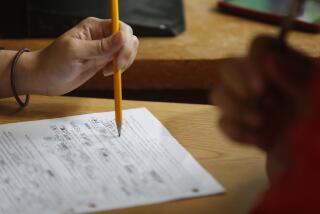Use a Learning Log to Chart Your Child’s Course to Success
- Share via
Most parents are willing to make the time and effort to help their children improve in a troublesome subject at school, but many encounter a big obstacle: How can you help your child with a subject that you don’t understand or have forgotten?
A potential solution is adapting for home use a teaching tool that is becoming more popular in California classrooms. It is called the learning log.
If the name reminds you of the famed Captain’s Log from “Star Trek,” that’s great, because the purposes are similar: to record the day’s learning and personal reactions to it.
Learning logs are fairly simple to create, use and monitor.
First, get a three-ring binder and a healthy supply of lined paper. (I discourage spiral notebooks because their unused pages become waste, and extra pages can’t be added when needed.) Keeping a separate notebook for each troublesome subject seems to prevent chaos and loss.
Entries are made after each session of learning, whether it’s a lecture, reading, discussion, lab experiment, film or guest speaker presentation.
Any learning done at home--such as via TV documentaries, computer software or rental videos--should also be included in the learning log.
Divide each page in half vertically (you’ll have left and right columns). It’s helpful at first to draw a line or make a crease down the middle--especially for younger students who tend to stray if there are no visible boundaries.
On either the left or right side of the page (it doesn’t matter which, but be consistent), your child will take notes on the learning session, whether it was a reading assignment, lecture, experiment or session on a computer.
Then, opposite the notes, your student will write his or her thoughts about them.
*
Ways to respond can include applying the material to daily life, comparing it to previously learned concepts, agreeing or disagreeing with ideas presented, evaluating the material’s importance or accuracy and listing confusing aspects or questions to be cleared up later.
An example: After reading about and taking notes on a historical event, the student may log some thoughts about whether he or she would have supported or protested the event, how history and the world would be different if the event hadn’t occurred or the circumstances that could cause such an event to happen again.
There’s no need for you to grade your son’s or daughter’s learning log, but offering special privileges or other incentives for its completion may help motivate a reluctant child.
Once an entry has been made, you’ve got a great foundation for discussing the material and measuring your child’s understanding. So what if you don’t know anything about the topic; now you’ve got a nuts-and-bolts summary of it and can now be of help to your child.
But that’s just one of many benefits of using a learning log at home for a subject that is giving your child a hard time.
The log also provides your student with a handy summary of all learning, which is then helpful for exam reviews and class assignments.
The frequent writing also improves the student’s fluency--his or her ability to quickly write down a flurry of thoughts and ideas.
Learning logs also force a student to actually think about the material, instead of just memorizing facts.
*
Most important, though, the student’s responses help pinpoint problems within a subject. That helps you ask for the teacher’s help much more effectively. For example, instead of saying “Sherry just doesn’t understand literature,” it’s now possible to say, “Sherry had trouble identifying irony in the last two short stories you assigned.”
It’s also easier to get a teacher’s help when your child has listed, in his or her learning log, some specific questions or sources of confusion.
And I’m sure I don’t have to remind you of the pleasure and value of the parent-child bonding that occurs when you read, talk and learn together.






